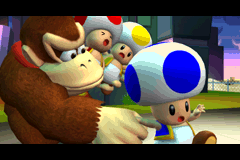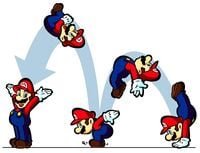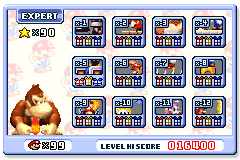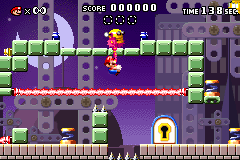Mario vs. Donkey Kong
- This article is about the first game in the Mario vs. Donkey Kong series. For other uses, see Mario vs. Donkey Kong (disambiguation).
| Mario vs. Donkey Kong | |||||||||||
|---|---|---|---|---|---|---|---|---|---|---|---|
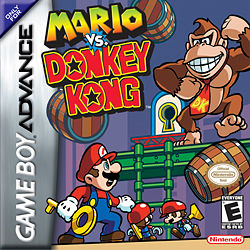 American box art For alternate box art, see the related gallery. | |||||||||||
| Developer | Nintendo Software Technology Corporation | ||||||||||
| Publisher | Nintendo | ||||||||||
| Platforms | Game Boy Advance, Virtual Console (3DS, Wii U) | ||||||||||
| Release dates | Game Boy Advance: Virtual Console (3DS) (Ambassador Program Release): Virtual Console (Wii U): | ||||||||||
| Languages | English Japanese French (France) German Italian Spanish (Spain) | ||||||||||
| Genres | Puzzle/Action | ||||||||||
| Ratings |
| ||||||||||
| Mode | Single Player | ||||||||||
| Format | Wii U: Game Boy Advance: Nintendo 3DS: | ||||||||||
| Input | Wii U: Game Boy Advance: Nintendo 3DS:
| ||||||||||
| Serial codes | |||||||||||
Mario vs. Donkey Kong is a puzzle platformer for the Game Boy Advance. Its gameplay and scenario are heavily inspired by Donkey Kong for the Game Boy, as it features the return of many elements from that game, such as the primary setting of a construction site, Mario's athleticism, his usage of the hammer, and his rivalry with Donkey Kong. It also borrows elements from Super Mario Bros. 2, especially in terms of Mario's more complex movement mechanics and how he can pick up and throw enemies and items. The level design of Mario vs. Donkey Kong is more puzzle-focused than previous platformers in the franchise; Mario must find the best route to complete the level by hitting switches and interacting with other objects, often in a specific order to reach the goal. This game spawned multiple sequels and became the first installment of the Mario vs. Donkey Kong series; this is the only game in the series, however, to feature Mario himself as a playable character, since the later games have the player control Mini-Marios.
The game was re-released as a free downloadable title for the Nintendo 3DS on December 16, 2011. However, it was only available to people who purchased a Nintendo 3DS prior to the August 12, 2011 price drop, meaning that they had to be a part of the Nintendo 3DS Ambassador Program. It was re-released again on the Wii U's Virtual Console in Japan on July 23, 2014, in Europe on September 17, 2015, in Australia on September 18, 2015, and in the Americas on February 9, 2017.
A remake of the same name was released for the Nintendo Switch on February 16, 2024.
Story[edit]
The following text is taken from page 6 of the North American instruction booklet for the game:
It looks like Donkey Kong is up to his old tricks again!
Over in the Mushroom Kingdom, Mario has become so famous that he's started his own toy company. His new Mini-Mario action figures are all the rage, and this cute li'l wind-up toy is just flying off the shelves.
In fact, these toys are so popular that stores can't even keep them in stock. Donkey Kong just loves these new toys, but when he showed up at the store, they were all gone!
Donkey Kong's not famous for his patience, and he wasn't about to wait for the next shipment, so he just went straight to the factory and started grabbing all the new Mini-Marios for himself. Mario arrived just in time to see Donkey Kong run off with all his inventory!
Now it's up to you to help Mario recover his stolen trinkets and give Donkey Kong a good talking-to for not pre-ordering!
Mario has become so famous and popular in the Mushroom Kingdom that he has decided to establish the Mario Toy Company, which has developed a new toy called the Mini-Mario. In the opening cutscene, as Donkey Kong surfs through the channels of his television set, he sees a commercial for the Mini-Marios. Donkey Kong instantly adores the toys and heads to the Toy Store to buy some, but finds that they are all sold out. Donkey Kong turns around and sees the Mario Toy Company, deciding to loot it of its Mini-Marios.
In the cutscene played when starting a file, the factory where the Mini-Marios are produced is shown to be managed by three Toads. Upon seeing Donkey Kong barge into the factory, the Toads become frightened; they are unable to stop Donkey Kong from stealing the toys, as he collects Mini-Marios encased in crystal balls and places them into a large bag with his emblem, leaving the building afterward. Mario then notices Donkey Kong and starts chasing him.
After Mario chases Donkey Kong across six worlds, Donkey Kong checks his bag only to realize that it is empty, as all the Mini-Marios he stole have dropped. Mario, the Mini-Marios, and the three Toads laugh at Donkey Kong for this; enraged, Donkey Kong grabs the three Toads and climbs to the top of a tall building under construction. Mario rescues the three Toads and defeats Donkey Kong, causing him to fall off the building while the end credits roll; however, after this, a truck containing additional Mini-Marios pulls up to the building, which Donkey Kong falls directly onto. The Mini-Marios fall onto the ground and their crystal balls break, leaving them clamoring as they surround Donkey Kong. Mario asks Donkey Kong if he is okay before Donkey Kong immediately steals the Mini-Marios surrounding him, prompting Mario to give chase once again.
After Mario chases Donkey Kong through six more worlds, Donkey Kong checks his bag a second time. Presuming that Donkey Kong's bag is empty, Mario laughs at him until six Mini-Marios drop from the bag, which Donkey Kong grabs as he flees. Finally, Donkey Kong faces Mario in a giant robot holding the Mini-Marios, which Mario promptly frees while fighting Donkey Kong, eventually wrecking the machine and electrocuting Donkey Kong in the process. After this, Mario is about to scold Donkey Kong for what he did, but finds that Donkey Kong is crying in pity and shame. Mario cheers him up by giving him a free Mini-Mario. Donkey Kong gets what he has wanted all along, while Mario and the remaining Mini-Marios celebrate as the true end credits roll.
Gameplay[edit]
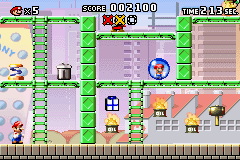
Each of the game's six worlds is divided into eight levels, totaling 48 levels altogether. For the first six levels within each world, Mario must find a key and open up a door to the second half of the level, which is a checkpoint. There, Mario will find the Mini-Mario toy that Donkey Kong dropped. Mario must pick up and shatter the crystal ball that the Mini-Mario is trapped in to complete the level. If Mario is defeated in the second half of the level, his points reset back to the points he earned in the first half of the level. At the beginning of each level, there is a short sequence of automatic gameplay showing what Mario needs to do or what he may face before playing the level. This sequence also explains what moves Mario needs to use to complete the level, displaying combinations of buttons to press.
Unlike games in the Super Mario series of platformers, Mario always loses a life upon taking damage, and cannot improve his defensive capabilities. Different methods of losing a life cause different animations to play that show Mario being injured, accompanied by three unique musical jingles; these include the standard animation of collapsing onto the ground, being set on fire, electrocuted, squished, and falling from a large height and landing on his head. If the fall is not big enough, Mario may land on his back instead, stunning him and leaving him vulnerable for a short time.
Each level also features a time limit, which acts identically to that of the Super Mario series. If the time limit reaches 30 seconds, Mario exclaims "Hurry, hurry, hurry!" and a warning theme starts to play, which is an arrangement of the theme in the same scenario from Donkey Kong for the Game Boy. If the time limit runs out, Mario will say "Mamma mia, time's up!" and he loses a life. When Mario grabs the key and opens a locked door, the remaining time in the first area will be added to the time limit in the second area. In the Japanese and European versions of the game, this is made explicitly clear by the numbers of the time limit being sucked into the door as Mario leaves, whereupon they are shown being added to the second area's time limit with a addition symbol.
Mario can perform additional moves besides jumping, such as handstands and backflips. To defeat enemies, Mario must pick up objects and throw them at enemies, reminiscent of Super Mario Bros. 2. Throughout the level, there are some collectibles that Mario can collect. Collecting the three presents in each level are pivotal in earning a high score. Earning a high enough score to beat the default score earns a star for that level. The stars are later used to unlock Expert levels.
Once Mario completes a level and collects enough presents, he can play a short bonus game[12] to earn extra lives. One present may have a 1-Up Mushroom, one may have a 2 UP, another may have a 3 UP or a 5 UP, and one present may have a Donkey Kong head that gives zero lives; the contents of each present are shown at the beginning of the bonus game. One bonus game has the player stop a scrolling arrow by pressing ![]() when the arrow is directly on top of their desired present, while the other has Mario quickly swapping presents so that Donkey Kong's fist squashes undesired presents.
when the arrow is directly on top of their desired present, while the other has Mario quickly swapping presents so that Donkey Kong's fist squashes undesired presents.

The seventh level in each world is a Mini-Mario level. Mario leads the six Mini-Mario toys he collected back to their toy box; however, he must make sure they avoid obstacles along the way. This leads into a battle with Donkey Kong, with each Mini-Mario saved becoming a health point.[13] For example, if Mario saves all six of the Mini-Mario toys, he will be able to be hit six times by Donkey Kong before losing a life. If Mario runs out of time or loses all of his health points, the player will lose a life and must restart the battle with Donkey Kong. If the player does not complete the Mini-Mario level before entering the boss battle, Mario will start the fight with four health points, and getting a Game Over will require Mario to replay the Mini-Mario level.
After Mario has beaten the six worlds and defeated Donkey Kong, six Plus Worlds are unlocked, numbered 1+, 2+, and so on. There are six standard levels and one boss level in each Plus World, and there are no Mini-Mario levels. Mario must get to a Mini-Mario holding a key and lead it to the door. If either Mario or Mini-Mario is defeated, the player loses a life and must restart the level. There is only one part per level in the Plus Worlds, and they are designed to be more difficult than the main worlds. There are still Donkey Kong boss levels in the Plus Worlds. In those levels, the player always starts with six health points and has 120 seconds to defeat Donkey Kong except in Donkey Kong Plus, where they have 300 seconds.
For the Expert levels, a certain number of stars collected by beating high scores are required to unlock levels. There are twelve Expert levels. Additionally, if the player leaves or restarts the level in any mode before they clear the level for the first time, they lose a life. If the level is already complete, the player will not lose a life when choosing to exit the level. However, the player will still lose a life if they retry the level, even if it is completed. No bonus game is played after collecting all the presents in the Expert levels.
Controls[edit]
 - Jump
- Jump - Pick up item
- Pick up item - Move Mario
- Move Mario /
/ - Select between worlds
- Select between worlds- Pause and continue game
In any level (including boss levels), pressing ![]() and
and ![]() at the same time activates Free Scroll Mode,[14][15] pausing gameplay and allowing the camera to be moved freely with the
at the same time activates Free Scroll Mode,[14][15] pausing gameplay and allowing the camera to be moved freely with the ![]() D-Pad. Pressing
D-Pad. Pressing ![]() in this mode returns to regular gameplay.
in this mode returns to regular gameplay.
Mario's moves[edit]
- Jump (
 )
) - Handstand (Down
 +
+  )
) - Handstand Jump (
 while handstanding)
while handstanding) - Handstand Double Jump (
 after touching the ground from a Handstand Jump)
after touching the ground from a Handstand Jump) - Backflip (while facing right) (Left
 +
+  )
)
Worlds[edit]
| Main worlds | |
|---|---|
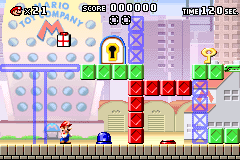
|
World 1 Mario Toy Company The first world, where Donkey Kong stole the Mini-Mario toys. This world features Garbage Cans, Shy Guys, and a few other gimmicks. Levels 1-1 • 1-2 • 1-3 • 1-4 • 1-5 • 1-6 • 1-mm • 1-DK |
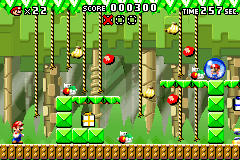
|
World 2 Donkey Kong Jungle Donkey Kong's next stop, featuring ropes, Monchees, Snapjaws, and more. Levels 2-1 • 2-2 • 2-3 • 2-4 • 2-5 • 2-6 • 2-mm • 2-DK |
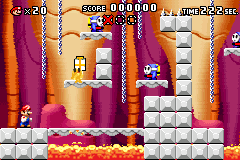
|
World 3 Fire Mountain An area with high volcanic activity, featuring Podoboos, fire birds, and Shy Guys equipped with flamethrowers. Levels 3-1 • 3-2 • 3-3 • 3-4 • 3-5 • 3-6 • 3-mm • 3-DK |
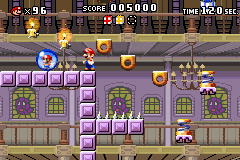
|
World 4 Spooky House A haunted mansion, featuring Boos, Polterguys, Thwomps, and others. Levels 4-1 • 4-2 • 4-3 • 4-4 • 4-5 • 4-6 • 4-mm • 4-DK |
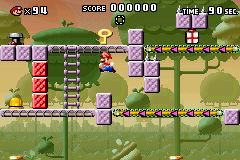
|
World 5 Mystic Forest A forest world featuring mechanical elements such as Bob-ombs, Conveyor Belts, and other gimmicks. Levels 5-1 • 5-2 • 5-3 • 5-4 • 5-5 • 5-6 • 5-mm • 5-DK |
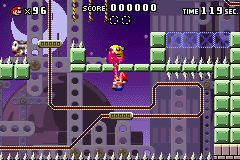
|
World 6 Twilight City An ultramodern city featuring robotic Monchees and lasers. Levels 6-1 • 6-2 • 6-3 • 6-4 • 6-5 • 6-6 • 6-mm • 6-DK |
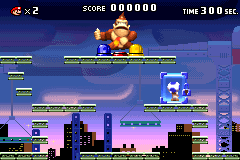
|
World DK Donkey Kong The final boss stage in the main part of the game, set apart from other worlds. |
| Plus worlds | |
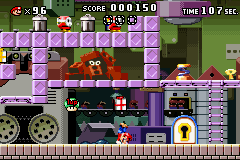
|
World 1+ Mario Toy Factory Levels 1-1+ • 1-2+ • 1-3+ • 1-4+ • 1-5+ • 1-6+ • 1-DK+ |
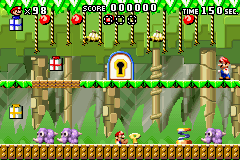
|
World 2+ Donkey Kong Jungle Plus Levels 2-1+ • 2-2+ • 2-3+ • 2-4+ • 2-5+ • 2-6+ • 2-DK+ |
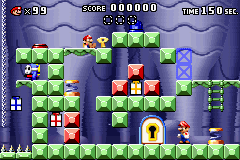
|
World 3+ Fire Mountain Plus Levels 3-1+ • 3-2+ • 3-3+ • 3-4+ • 3-5+ • 3-6+ • 3-DK+ |
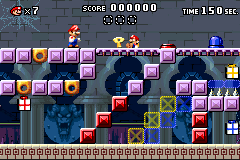
|
World 4+ Spooky House Plus Levels 4-1+ • 4-2+ • 4-3+ • 4-4+ • 4-5+ • 4-6+ • 4-DK+ |
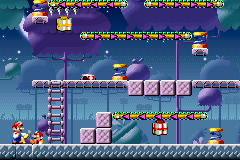
|
World 5+ Mystic Forest Plus Levels 5-1+ • 5-2+ • 5-3+ • 5-4+ • 5-5+ • 5-6+ • 5-DK+ |
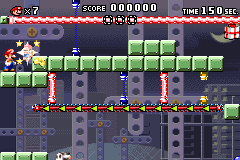
|
World 6+ Twilight City Plus Levels 6-1+ • 6-2+ • 6-3+ • 6-4+ • 6-5+ • 6-6+ • 6-DK+ |
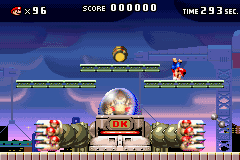
|
World DK+ Donkey Kong Plus The final boss stage of the game, where Mario confronts a mech-piloting Donkey Kong. |
Expert[edit]
- Main article: Expert (world)
The Expert levels are a group of twelve levels that test the player's skills. The level set is first unlocked by defeating the true final boss, with each level in the set being progressively unlocked based on the number of stars the player has collected throughout the game. Each of these levels are contained in a single room, and to beat them, the player must find the key in the level to go through the door. With the exception of boss levels, these are the only levels in the game that do not involve Mini-Marios. There are no set high scores for these levels, and collecting all three presents in a level does not let the player play one of the bonus games. The music that plays during the Expert levels is at a faster tempo, and gradually increases in tempo as the time limit decrements.
- Level x-1
- Level x-2
- Level x-3
- Level x-4
- Level x-5
- Level x-6
- Level x-7
- Level x-8
- Level x-9
- Level x-10
- Level x-11
- Level x-12
Mario vs. Donkey Kong-e[edit]
- Main article: Mario vs. Donkey Kong-e
A game mode with e-Reader support can be enabled by connecting a Game Link Cable to the Game Boy Advance. This mode utilizes e-Reader cards to allow new levels to be played, where Mario is given unlimited lives. The e-Reader levels follow the same format as the Expert levels, featuring a single room with a key and the door, and they likewise do not have a set high score or a bonus game. A total of six e-Reader cards for the game were released in Japan; however, additional unused levels exist in the game's code. Although this mode is also present in the North American release, no e-Reader cards for the game were distributed in that region, leaving the entire mode unused.
The following levels have corresponding e-Reader cards that were officially distributed in Japan:
Items and objects[edit]
| Image | Name | Description |
|---|---|---|
| Key | Keys are found in the first half of every regular level of the game. They must be taken to locked doors in order to open the second half. In the Plus levels, each Mini-Mario is holding the key needed to unlock the level's door. | |
| Mini-Mario | Mini-Marios are the objective of the second half of the normal levels, where they must be rescued from crystal balls. They follow Mario in Mini-Mario levels. In the Plus levels, there is one Mini-Mario per stage, which must be rescued and brought to the door to beat the level. | |
| 1-Up Mushroom | 1-Up Mushrooms give Mario an extra life. | |
| Color Switch | Color Switches are found in three variations: red, yellow, and blue. As its main effect, the switch that is active makes platforms, Color Blocks, and ladders of the same color available to use. | |
| Color Block | Color Blocks can be active or inactive to create walls or platforms, depending on which Color Switch is currently active. | |
| Spring | Springs help Mario jump higher. They can also be used by Mini-Marios. | |
| Conveyor Belt | Conveyor Belts appear in large groups in some levels. They are used to transport keys and to help Mario through narrow areas. Their direction can be changed with a Direction Switch. | |
| Donut Block | Donut Blocks are platforms that fall down if Mario or Mini-Mario stays on them for too long. | |
| Elevator | Elevators are found moving on lines. Their directions can be changed with a Direction Switch. | |
| Wire | Metal bars that Mario can grab onto to move across gaps or swing upwards. | |
| Ladder | Ladders can be climbed to reach higher places. Some ladders are activated by Color Switches. | |
| Rope | Objects that hang from ceilings. Mario can climb or descend them, and he can also grab two ropes at the same time. | |
| Chain | Chains function identically to ropes, replacing them in worlds such as Fire Mountain and Twilight City. | |
| Crumble Block | Blocks that crumble into dust when stood on. | |
| Garbage Can | These items can be carried and thrown by Mario. He can use them to defeat certain enemies, as auxiliary platforms to reach other platforms, or to move across long gaps with spikes. | |
| Barrel | ||
| Hammer | Hammers are found floating on platforms. Mario can use them to defeat enemies, such as Oil. They can be thrown upwards and grabbed again while in the air. | |
| Present | Presents are found in red, yellow, and blue varieties. When all three are collected in a level, they are used in a bonus game where the player can win extra lives. | |
| Letter | The letters T-O-Y are found in Mini-Mario levels. They must be collected by Mini-Marios to open the toy box. | |
| Toy box | Toy boxes are the goal of the Mini-Mario levels. If the letters T-O-Y are collected, it opens and allows Mario to drop off his Mini-Marios. | |
| Help Box | Help Boxes appear in several levels. When touched, it reminds the player how to perform one of Mario's moves. |
Enemies and obstacles[edit]
| Image | Name | Description | Levels | |
|---|---|---|---|---|
| First | Last | |||
| Bat | Bats are enemies that, once released, fly horizontally through the stage. If they touch Mario, they latch on to him, stunning him and causing him to fall from the rope he is climbing. | Level 5-4 | Level 5-5+ | |
| Bird | Small birds that fly horizontally once they leave their nests. They also drop polka-dotted eggs at Mario. | Level 2-3 | Level 2-4+ | |
| Bob-omb | Bob-ombs are dropped out of dispensers. They light their fuses when Mario is near and explode moments later. They can be used to destroy Bob-omb Blocks to progress. | Level 5-3 | Level x-12 | |
| Boo | Boos appear in Spooky House. They chase Mario when he is not looking at them, and remain still while being watched. | Level 4-4 | Level 4-4+ | |
| Brickman | Brickmen are placed on platforms. They throw a line of three bricks underneath them, forcing Mario to handstand to avoid being hit. | Level 1-6 | Level 6-2+ | |
| Bucket Man | Bucket Men hide inside Garbage Cans to confuse the player. They reveal themselves if Mario hops on them, they will start walking. Mario cannot grab and throw them as ordinary Garbage Cans, but rather use them as moving platforms during their motion to get past spike pits. These creatures can be defeated by throwing another object at them. | Level 1-4 | The Long Way | |
| Candle | Candles appear in Spooky House, where they float up and down. | Level 4-2 | Level 4-2 | |
| Cannon and Cannonball | Cannons tilt up and down, shooting cannonballs. | Level 5-4 | Level 5-6+ | |
| Falling spike | Falling spikes fall from ceilings when Mario gets near them. When they get stuck on the ground, they act as temporary platforms for the player. | Level 4-3 | Level 4-DK+ | |
| Fire bird | Flaming birds that appear in Fire Mountain. They also drop burning eggs at Mario. | Level 3-2 | Level x-9 | |
| Fireball | Fireballs walk from side to side on an area. They burn Mario once they touch him. | Level 1-2 | The Long Way | |
| Laser | Beams of energy that fire periodically depending on their color. They electrocute Mario on contact. | Level 6-1 | Laser Panic! | |
| Lava Geyser | Lava Geysers rise out of pits of lava and cause platforms to float on top of them, allowing Mario to reach higher ground. | Level 3-1 | Level 3-4 | |
| Monchee | Monchees are mechanical monkeys with long tails that hang below the platforms they are on. Mario can use these tails as ropes without getting harmed. However, he still loses a life if he touches a Monchee's body. | Level 2-3 | One Shot Blue | |
| Ninji | Simple enemies that jump up and down, which can help Mario reach higher areas. They are invincible. | Level 3-1 | Level x-9 | |
| Oil | Burning oil cans with "OIL" written on their sides. They move up and down and burn Mario if he touches them. | Level 1-2 | Level 1-3+ | |
| Podoboo | Podoboos are found jumping out from lava. They can burn Mario if he touches them, and they cannot be defeated. | Level 3-3 | Level x-3 | |
| RamRam | RamRams are found in jungle levels. Despite being enemies, they are used as platforms occasionally. They can be defeated by colliding with fruit, another enemy, or an object. | Level 2-2 | One Shot Blue | |
| Robo Kikki | Robots that act similar to Monchees, but move faster. | Level 6-3 | Laser Panic! | |
| Shy Guy | Simple enemies that move side to side continuously. | Level 1-1 | Level x-7 | |
| Fire Shy Guy | Fire Shy Guys are found in Fire Mountain. Besides walking from side to side, they also shoot fire that can harm Mario. | Level 3-3 | Level x-9 | |
| Polterguy | Polterguys move from side to side. There are three variations of this species: blue, red, and yellow. If a Color Switch of their respective color is pressed, they turn into safe, stationary blocks. | Level 4-3 | Level x-10 | |
| Spear Guy | Spear Guys are first found sleeping. Once Mario gets near them, they wake up and start running after him. They go back to sleep if they touch a platform's edge. | Level 5-2 | Level 5-5+ | |
| Wrench Shy Guy | Wrench Shy Guys appear in Twilight City. When they spot Mario, they gasp and attack by throwing wrenches horizontally. | Level 6-1 | Level 6-4+ | |
| Sir Shovalot | Stubby knight-like enemies that are first seen moving along the ground. Once they spot Mario, they quickly move towards him and use their front armor to shove him. This can be harmful if Mario is squished between the armor and a wall, but it can also help him go through narrow places if he ducks beforehand. Sir Shovalots cannot be defeated in any manner. | Level 4-2 | Level 6-5 | |
| Snapjaw | Snapjaws are seen climbing ropes in forest levels. They can be only defeated by falling fruit. | Level 2-5 | Level 2-5+ | |
| Spiked Barrel | Donkey Kong throws Spiked Barrels at Mario in one of the boss stages, alongside large barrels with his emblem. Neither of these barrel types can be stood on, and will instead hurt Mario on contact. | Donkey Kong | Donkey Kong | |
| Spikes | Hazards that remain in place and are lethal to Mario. | Level 1-3 | Laser Panic! | |
| Tane Pakkun | Tane Pakkun are found stationary on platforms, usually near ropes. They spit seeds to harm Mario. | Level 2-1 | Danger Flowers | |
| Thwomp | Thwomps watch the ground and try to crush Mario if he walks under them. Switch-controlled blocks can be used to prevent them from reaching the player. If Mario touches them in any way, including standing on top of them, he will lose a life. | Level 4-1 | The Thwamplet | |
| Thwomp Platform | Thwomp Platforms fall from the ceiling, just like normal Thwomps. However, they keep rising and falling in a set pattern even if Mario is not near. They can be used as platforms. | Level 3-2 | Level x-9 | |
| Thwimp | Thwimps jump from side to side, trying to crush Mario. They are invulnerable. | Level 4-1 | Level x-4 | |
| Wire Trap | Balls of electrical energy that move across wires. | Level 1-4 | Level 6-6 | |
| Donkey Kong | Donkey Kong is the only boss of the game, fought in every world. In each of his fights, he attacks Mario in a different manner. | Level 1-DK | Donkey Kong Plus | |
Staff[edit]
- Main article: List of Mario vs. Donkey Kong staff
Mario vs. Donkey Kong is one of the few Super Mario games to be developed by an American team, Nintendo Software Technology Corporation (NST). In NST's team, Shigeki Yamashiro is the producer while Yukimi Shimura is the director. Wing S. Cho designed the game and Yoonjoon Lee is the engineering director.
Development[edit]
- This section is about the unreleased game canceled in favor of Mario vs. Donkey Kong. For the world and level in Mario vs. Donkey Kong, see vs. Donkey Kong Plus.
- Main article: List of Mario vs. Donkey Kong pre-release and unused content
Donkey Kong Plus, an updated version of the Game Boy Donkey Kong, was initially planned. The only known difference between the original and Plus, aside from the graphics, was the addition of a level designer to be used through the Nintendo GameCube for players to create their own levels with. However, the game vanished the following year in favor of Mario vs. Donkey Kong, with the level editor gone and the graphics replaced with pre-rendered graphics. The game's sequel, Mario vs. Donkey Kong 2: March of the Minis, reintroduced the level editor feature in the form of the Construction Zone, which made use of Nintendo Wi-Fi Connection.
Quotes[edit]
- Main article: List of Mario vs. Donkey Kong quotes
Mario[edit]
- "Come back here, you big-a monkey!"
- "Ah, that Charles Martinet. Nice Italian boy!"
- "Oh yeah, don't forget to thank Mr. Miyamoto!"
- "Let's-a go, little guys!"
Glitches[edit]
Game softlock[edit]
In the second room of Level 4-3, Mario must go near the spring on the far right side of the screen. When the bottommost red Polterguy is close to the invisible wall on the right side of the screen, but is not touching the wall, Mario must press the red switch to turn the Polterguy into a stationary block. If the space in between the Polterguy and the wall is roughly equivalent to the width of Mario's sprite, Mario must perform a high jump on the spring while moving to the right. If performed correctly, Mario will not collide with the invisible wall, causing him to fly off screen, where he falls briefly until taking damage. At this point, Mario would normally lose a life and the room would be restarted; however, instead, all elements of the level continue to move indefinitely without the timer decrementing, putting the game in an unwinnable state, where the only action the player can take is to reset the system.[16]
Mario floats in midair while crushed[edit]
In Level x-3, if Mario gets crushed by a Thwomp Platform while standing on a lift platform, Mario will be flattened and lose a life, but as the animation of him floating to the ground is played, he will still follow the movements of the platform. This can cause Mario to continuously float in the air, and can also cause him to float upwards.[17]
Stopped voice clips[edit]
At any time when the player is opening a locked door, they can press ![]() and
and ![]() at the same time to activate Free Scroll Mode. When this mode is exited, the music jingle at the end of a level will still play, but the door's sound effects and Mario's sound effects will not, due to being interrupted by the sound effect of Free Scroll Mode being cancelled.[18]
at the same time to activate Free Scroll Mode. When this mode is exited, the music jingle at the end of a level will still play, but the door's sound effects and Mario's sound effects will not, due to being interrupted by the sound effect of Free Scroll Mode being cancelled.[18]
Reception[edit]
Mario vs. Donkey Kong is generally well-received by critics, aggregating an average of 81/100 on Metacritic[19] and 79.07% on GameRankings.[20] Craig Harris of IGN gave the game an 8.5/10, "Great".[21] Harris praised the game for having "faithfully retained the Donkey Kong arcade game's look and feel". His reaction is mild about the Donkey Kong boss levels, calling them "the ones with the least amount of creativity". He criticized the presentation, calling the sprites "awkward but admittedly well-animated 3D rendered" while the voice-overs from Mario and Donkey Kong are unnecessary, although not distracting. Despite these, he praises the game's faithfulness of the Game Boy Advance Donkey Kong games, with its fantastic level design and lasting appeal.
Marcel van Duyn of Nintendo Life has echoed some of IGN's statements, deeming the game to be "a worthy successor", giving the game an 8/10.[22] As in the IGN review, Duyn criticized the game's pre-rendered sprites, saying that it "although it actually looks pretty good, it's a bit strange to see this style in a Nintendo title again after all this time." Duyn is disappointed that "the series has only had Lemmings-esque installments since", believing "the original formula is perfectly worthy of another day in the limelight."
In a more critical review, Stephen Carvell of VideoGamer praises the game's visuals, but criticizes the game's level design, calling the reliance on the color-coded switches "tedious" and the later levels for using the same puzzles. He also criticized the Mini-Mario levels for having "appalling level design that smacks of a lack of ideas." He gave the game a 6/10.[23]
| Reviews | |||
|---|---|---|---|
| Release | Reviewer, Publication | Score | Comment |
| Game Boy Advance | Craig Harris, IGN | 8.5/10 | "All of the well-established gameplay elements of the original have returned in new and fun platformer challenges with a decidedly different theme and flavor, taking advantage of the more powerful GBA platform. Strangely, Nintendo has seemingly ignored the game's roots instead of simply embracing them, playing off this game as a separate and "new" franchise instead of positioning it as what it really is: a continuation of one of the best, most recommended Game Boy titles in the system's library. Because the new design takes such a drastically different approach in its art style and presentation it feels just a little awkward to those who enjoyed the original Game Boy Donkey Kong and its faithful retroness. Beyond that element, though, there's a lot to enjoy in Mario vs. Donkey Kong, and its new production is still a can't-miss action title for the Game Boy Advance." |
| Game Boy Advance | Tom Bramwell, Eurogamer | 8/10 | "It won't come as anything new or inspiring to anybody who's tackled a DK title before, but it engages the brain in ways that we enjoy being probed, and for all its age the formula is still as sound as ever. Meanwhile, it's a new thrill for a younger generation of handheld owners, and has the potential to be a fantastic stocking filler for anybody who likes to haul out the console on a train or bus to school. It's not the most imaginative, it won't last forever, and we're not particularly sold on the pre-rendered visual approach (give us something from Yoshi's Island any day), but it's hard to argue with any game where every level feels like slotting in the last piece of a jigsaw puzzle." |
| Game Boy Advance | Jeff Gerstmann, GameSpot | 8/10 | "Mario vs. Donkey Kong is a standout game that fans of portable puzzles will have a good time with. It also plays the nostalgia card very well, making references all over the place. The music will occasionally go all the way back to the original Donkey Kong, including the classic "I've got a hammer" music. The game also includes vines and droppable fruit like in Donkey Kong Jr., acrobatic moves that are reminiscent of Super Mario 64, and the ability to stand on, pick up, and toss enemies just like in Super Mario Bros. 2. Both on its own and as a tribute to Mario's legacy, Mario vs. Donkey Kong does a great job." |
| Aggregators | |||
| Compiler | Platform / Score | ||
| Metacritic | 81 | ||
| GameRankings | 79.07% | ||
Gallery[edit]
- For this subject's image gallery, see Gallery:Mario vs. Donkey Kong.
Mario holding a key
Mario breaking a Mini-Mario's crystal ball
Donkey Kong holding a barrel
Multimedia[edit]
- For the complete list of media files for this subject, see Multimedia:Mario vs. Donkey Kong.
| File info 0:30 |
| File info 0:03 |
| File info 0:02 |
References to other games[edit]
- Donkey Kong (Arcade/NES)
- "Title BGM" is arranged in the title screen music.
- "Game Start" is arranged in the introductory cutscene's music and the boss music.
- "Hammer BGM" theme plays while using a hammer.
- When being defeated by an enemy or running out of time, the music that plays contains a sequence of descending arpeggios, much like the death fanfare from this game.
- Snapjaws appear as enemies.
- The Ground BGM is arranged in the title screen music.
- Shy Guys appear as the first enemies that Mario encounters to illustrate that he must pick up and throw enemies to defeat them, in a similar manner to this game.
- Mario is able to perform Handstands, Handstand Jumps, Backflips, Wire Spins, pick up items, and throw items.
- Hammers can be thrown upwards.
- Monchee, Bucket Man, Sir Shovalot, and Oil return.
- The battle in vs. Donkey Kong Plus is mechanically identical to the battle in Stage 9-9.
Names in other languages[edit]
| Language | Name | Meaning | Notes |
|---|---|---|---|
| Japanese | マリオ Mario buiesu Donkī Kongu |
Mario vs. Donkey Kong |
Notes[edit]
- While Donkey Kong's voice uses recycled clips of Grant Kirkhope's voice from Donkey Kong 64 in all versions of the game, the Japanese commercial for the game features Donkey Kong being voiced by Takashi Nagasako, the voice actor for Donkey Kong from 2004 to 2025. However, in the Nintendo Switch remake, all of Donkey Kong's voice clips are from Nagasako.
- The title screen in the Japanese version was redone to feature the Mini-Marios, rather than feature Mario and Donkey Kong as is the case in the American and European versions. The presentation of the Japanese title screen was reused for the title screens of Mario vs. Donkey Kong 2: March of the Minis and Mario vs. Donkey Kong: Minis March Again!, even for the international releases.
References[edit]
- ^ Super Smash Bros. Brawl Chronicle
- ^ May 4, 2004. More Information on Mario vs. Donkey Kong. Nintendo World Report (American English). Retrieved July 29, 2024. (Archived September 3, 2023, 04:39:43 UTC via Wayback Machine.)
- ^ マリオvs.ドンキーコング. Nintendo Co., Ltd. (Japanese). Retrieved December 27, 2021. (Archived April 14, 2025, 21:03:54 UTC via Wayback Machine.)
- ^ a b Mario vs. Donkey Kong. Nintendo of UK (British English). Retrieved June 22, 2024. (Archived January 24, 2025, 09:34:00 UTC via Wayback Machine.)
- ^ マリオvs.ドンキーコング | Wii U | 任天堂. Nintendo (Japanese). Retrieved January 23, 2025. (Archived May 27, 2024, 07:26:46 UTC via Wayback Machine.)
- ^ "Nintendo finally brought Mario vs. Donkey Kong to the North American Wii U Virtual Console today." – Brian(@NE_Brian) (February 9, 2017). Mario vs. Donkey Kong Wii U Virtual Console gameplay. Nintendo Everything. Retrieved June 12, 2025. (Archived June 12, 2025, 23:28:48 UTC via Wayback Machine.)
- ^ Mario vs. Donkey Kong. Entertainment Software Rating Board. Retrieved June 12, 2025. (Archived June 12, 2025, 23:32:37 UTC via Wayback Machine.)
- ^ Mario vs. Donkey Kong Japanese box art
- ^ Mario vs. Donkey Kong European box art
- ^ Mario vs. Donkey Kong Australasian box art
- ^ MARIO VS DONKEY KONG. Australian Classification Board. Retrieved June 12, 2025. (Archived June 12, 2025, 23:34:04 UTC via Wayback Machine.)
- ^ "When you collect all three presents in a level, you get a chance to play one of two bonus games and maybe even win some extra lives." – 2004. Mario vs. Donkey Kong instruction booklet. Nintendo of America (American English). Page 26.
- ^ "For each Mini-Mario you rescue in that world's Mini-Mario level, you get an extra health point for your fight with Donkey Kong." – 2004. Mario vs. Donkey Kong instruction booklet. Nintendo of America (American English). Page 20.
- ^ Mario vs. Donkey Kong North American instruction booklet, page 9
- ^ Mario vs. Donkey Kong international instruction booklet, page 5
- ^ ThePowerPlayer (June 12, 2025). Mario vs. Donkey Kong - Level 4-3 Game Softlock Demonstration. YouTube. Retrieved June 12, 2025.
- ^ ThePowerPlayer (June 12, 2025). Mario vs. Donkey Kong - Level x-3 Floating in Midair Glitch Demonstration. YouTube. Retrieved June 12, 2025.
- ^ ThePowerPlayer (June 12, 2025). Mario vs. Donkey Kong - Stopped Voice Clips Glitch Demonstration. YouTube. Retrieved June 12, 2025.
- ^ Mario vs. Donkey Kong (2004). Metacritic (English). Retrieved February 28, 2025.
- ^ Mario vs. Donkey Kong. GameRankings. Archived December 9, 2019, 01:23:47 UTC from the original via Wayback Machine. Retrieved June 22, 2024.
- ^ Harris, Craig (May 24, 2004). Mario vs. Donkey Kong. IGN (American English). Retrieved June 22, 2024.
- ^ van Duyn, Marcel (January 10, 2012). Mario vs. Donkey Kong Review. Nintendo Life (English). Retrieved June 22, 2024.
- ^ Carvell, Stephen (February 8, 2005). Mario vs. Donkey Kong Review for GBA. VideoGamer.com (English). Archived September 8, 2013, 14:51:51 UTC from the original via Wayback Machine. Retrieved June 22, 2024.
- ^ Mario vs. Donkey Kong title screen (Japanese)

